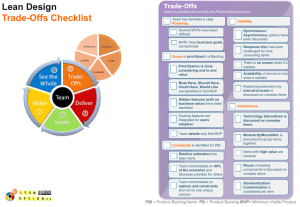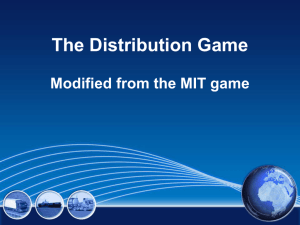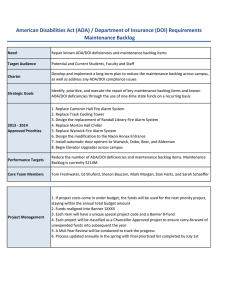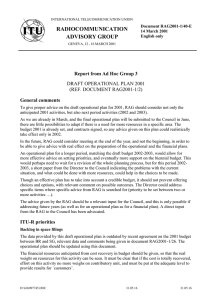Capital Development Update Minnesota State Colleges and Universities A new direction
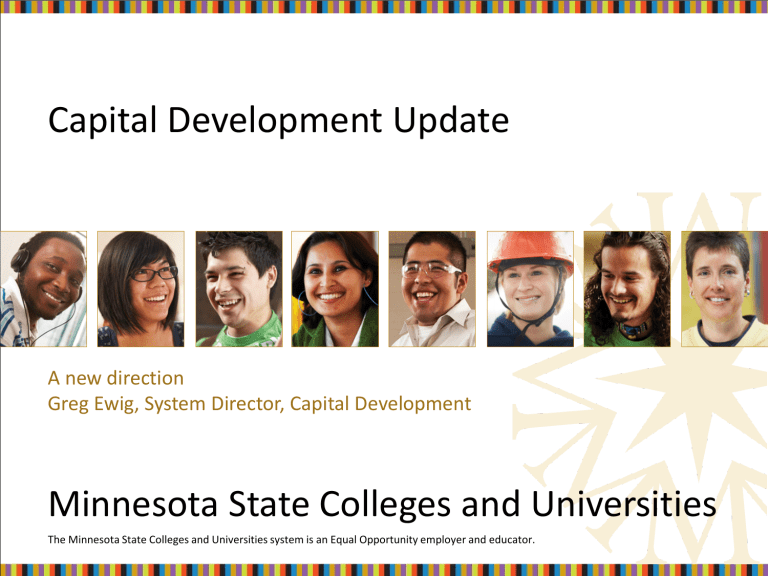
Capital Development Update
A new direction
Greg Ewig, System Director, Capital Development
Minnesota State Colleges and Universities
The Minnesota State Colleges and Universities system is an Equal Opportunity employer and educator.
2
Agenda
Capital Development
Capital Budget Update
Future Capital Plans
Master Plan
CEMRS
FRRM
Web and Sharepoint
3
Capital Development Team and
Areas of Responsibilities
Capital Budget
HEAPR
Revenue Fund
Space Planning
Predesigns
Real Estate
Energy
Sustainability
System Office Property
Management
4
5
Programs Staff
Capital Budget Lisa Jansen
HEAPR
Revenue Fund
Space Planning
Predesigns
Real Estate
Energy
Sustainability
System Office Property
Management
Ken Oas
Heather Anderson
Lisa Jansen, Stacy Brown
Lisa Jansen
Betty Ewens
Ken Oas
Ken Oas
Dale Johnson
6
Transition Plan
Step One - consolidating several groups
Planning & programming,
Revenue fund,
Real estate and
System office property / office management
Step Two – Assessing team
Step Three – Stabilizing and building relationships
Step Four – Do the work
7
Capital Budget Updates
2013 Capital Budget
House - $108M ($58M Projects (all) and $50M HEAPR)
Governor - $89M ($54M Projects and $35M HEAPR)
Senate – waiting to hear
2014 Capital Budget
Dependent on outcome of 2013
Next steps: Leadership Council and Board consideration – May / June
2015/6 Capital Budget
Recognize / respond to yearly capital bonding bill
Process reengineering
8
2013 Capital Budget
Location of Projects
Major Projects
Initiatives
X
# of projects at a location
2
3
2
9
Master Planning
Board Policy 6.4
Presidential responsibility
Three main criteria
Current Facilities Assessment
Plans for modernization, renewal and improved sustainability
Record of space utilization
5 year update schedule
Published Master Plan Guidelines
Updated schedule available as white paper
Master Planning
Time horizon
20 year target
Emphasis on 5-10 year plans
Master Plan Guidelines
1. Summary
2. Existing Site Conditions
3. Existing Building Conditions
4. Proposed Framework for Site Development
5. Proposed Framework for Building Development
6. Capital Budget Incremental Improvement Program
7. Appendix – (Residential life plan, academic planning, municipal)
10
11
Master Planning Major Issues
1.
Inventory of Sq. Ft. and Percentage of Room Type
Classroom/Labs – 24 / 12 large/ 12 medium, 150,000 sq. ft., 25%
Offices – 50 offices/ 25 hard wall/ 25 cubicle 25,000 sq. ft. 12%
i.e. Student Support, Administrative, Mechanical, Circulation, Athletic
2.
Local jurisdiction and regional consultation
3.
Space utilization and CEMRS integration
4.
Security and responding to COPE surveys
5.
Integrating supplemental work – parking studies, residential life master plans, repair and replacement studies
12
CEMRS Integration
CEMRS stands for Classroom, Event Management and
Resource Scheduling
Schedule
Finishing 3 rd group of schools
Last group starting in May
Costs
Invoices went out last month for 2013 costs
Based on FYE to reimburse initial investment and ongoing licensing
FY2013-17 -- $4.00 per full year equivalent
FY2017 onward - target is $2.00 per full year equivalent (subject to enhancements, future technical support)
13
CEMRS Roll Out Schedule
Number of Schools per Group
5
9
8
Group 1 (June '12)
Group 2 (Nov '12)
Group 3 (Feb '13)
Group 4 (May '13)
15
14
CEMRS - Last Group – Start in May
Central Lakes
Dakota County Technical College
Fond du Lac Tribal & Community College
Minnesota State – Southeast Technical
Northland Community & Technical College
Hibbing Community College
Rainy River
Vermilion Community College
Pine Technical College
15
CEMRS Action Plan (System)
Goal – Efficient use of space (Chancellor/Board)
System report development ongoing under CEMRS
ISRS Cleanup of Room Types
Major criteria – Room, Event and Group Types
New Reporting Observations:
New utilization driven by Event types
Moving away from narrow view of just Room Types 110/210
Describe the room for what it is
Eventually review of academic, credit use AND non-credit use
16
Facilities Renewal & Reinvestment
Model (FRRM)
Model - cost of current and future condition of buildings
Purpose – Planning and to support capital requests
Product – Backlogs, renewal and Facilities Condition Index
Timeline - FRRM Reports on a calendar year (December 31)
Translation - Look at current backlog to date
January – now – you know what’s dropped off
Now – December - Forecast to the end of 2013
For Example - HEAPR expected in 2013; but don’t remove until it’s appropriated
17
FRRM
Database open starting April 25 – June 25, 2013
Enter your backlog, renewal and any new buildings
Academic AND Revenue buildings
Training (April 25)
May schedule another training if necessary
18
Trendline for FRRM system backlog
Backlog in millions
720
705
700
684
680
660 654 654
640 632
Backlog
620
600
580
2008 2009 2010 2011 2012
Base year is 2005 for backlog calculation
Comparing 2005 Backlog With the 2012 Backlog
$1,400,000,000
$1,200,000,000
$1,000,000,000
$800,000,000
$600,000,000
$400,000,000
$200,000,000
$0
2005 Initial
Backlog
2006 Need 2007 Need 2008 Need 2009 Need 2010 Need 2011 Need 2012 Need Total Backlog if No
Investment
Inflation Difference Current
Backlog 2012
19
Showing the natural growth in backlog
Comparing 2005 Backlog With the 2012 Backlog
$1,400,000,000
$1,200,000,000
$1,000,000,000
$800,000,000
$600,000,000
$400,000,000
$200,000,000
$0
2005 Initial
Backlog
2006 Need 2007 Need 2008 Need 2009 Need 2010 Need 2011 Need 2012 Need Total Backlog if No
Investment
Inflation Difference Current
Backlog 2012
20
Scenario if no investment since 2005
Comparing 2005 Backlog With the 2012 Backlog
$1,400,000,000
$1,200,000,000
$1,000,000,000
$800,000,000
$600,000,000
$400,000,000
$200,000,000
$0
2005 Initial
Backlog
2006 Need 2007 Need 2008 Need 2009 Need 2010 Need 2011 Need 2012 Need Total Backlog if No
Investment
Inflation Difference Current
Backlog 2012
21
Scenario - No investment, add inflation
$1,400,000,000
$1,200,000,000
Comparing 2005 Backlog With the 2012 Backlog
$1.3B+ Backlog!
$1,000,000,000
$800,000,000
$600,000,000
$400,000,000
$200,000,000
Note on Inflation: Since these figures are based upon the 2005 analysis all the costs were based upon 2005 values. Therefore, inflation for each figure needs to be factored into the growth from
2005 to 2012. The actual inflation rate over the years was used for this chart to show what the projected backlog would have been based upon the 2005 analysis.
$0
2005 Initial
Backlog
2006 Need 2007 Need 2008 Need 2009 Need 2010 Need 2011 Need 2012 Need Total Backlog if No
Investment
Inflation Difference Current
Backlog 2012
22
Over $500M difference if no investment
Comparing 2005 Backlog With the 2012 Backlog
$1,400,000,000
$1,200,000,000
$1,000,000,000
$800,000,000
$600,000,000
$500M+
$400,000,000
$200,000,000
$0
2005 Initial
Backlog
2006 Need 2007 Need 2008 Need 2009 Need 2010 Need 2011 Need 2012 Need Total Backlog if No
Investment
Inflation Difference Current
Backlog 2012
23
Where we are today
Comparing 2005 Backlog With the 2012 Backlog
$1,400,000,000
$1,200,000,000
$1,000,000,000
$800,000,000
$600,000,000
$400,000,000
$200,000,000
$0
2005 Initial
Backlog
2006 Need 2007 Need 2008 Need 2009 Need 2010 Need 2011 Need 2012 Need Total Backlog if No
Investment
Inflation Difference Current
Backlog 2012
24
Predicting Future Capital Needs
Current Backlog and Annual Renewal Needs 2012-2022
$1,800,000,000
$1,600,000,000
$1,400,000,000
$1,200,000,000
$1,000,000,000
$800,000,000
$600,000,000
$400,000,000
$200,000,000
$0
$81,340,000
$90,617,000
$103,341,000
$79,431,000
$57,318,000
$72,882,000
$47,031,000
$84,937,000
$147,491,000
$1,554,134,000
$81,557,000
Current
FY10-11
Backlog
2013 Need 2014 Need 2015 Need 2016 Need 2017 Need 2018 Need 2019 Need 2020 Need 2021 Need 2022 Need Estimated
Backlog w/NO
Investment
Note: These projected figures are in 2012 constant dollars no inflation has been calculated for future costs 25
26
Facilities Renewal & Reinvestment
Model (FRRM)
Training
Thursday afternoon, 1-4:30 pm
Sightlines (formerly Pacific Partners)
Cover:
Creation of FRRM
System backlog
Comparison with other systems throughout the U.S.
Campus Backlog and renewals
Types of subsystems
Entering information on subsystems
27
Technology and Online Resources
Facilities Web Site
Capital Development
Planning
Real Estate
Revenue Fund
Capital Budget
Studies
Sharepoint sites
28
Capital Development:
Planning/Programming Section
Sharepoint Workplan
Active:
2014 Capital Budget Scoring (and future)
CEMRS
Enterprise Program Management System (EPMS)
Roll out
Master Planning
Revenue Fund Projects
Facilities Policies and Procedures
Public Safety and Compliance
29
30
New Site for updating Master Plans
31
Other Topics
Facilities Policies and Procedures re-engineering
Revenue Fund kick off for 2015 bond sale
Repair & Replacement Cost Accounting
Energy Consumption Data
Use of Bond Proceeds
Regional master planning
Master Plan guideline updates
Sustainability
Redevelopment Energy Grants
Guaranteed energy savings contracts
32
Thank you
Questions?
Greg Ewig, Director, Capital Development
651.201.1775
Gregory.ewig@so.mnscu.edu
33
